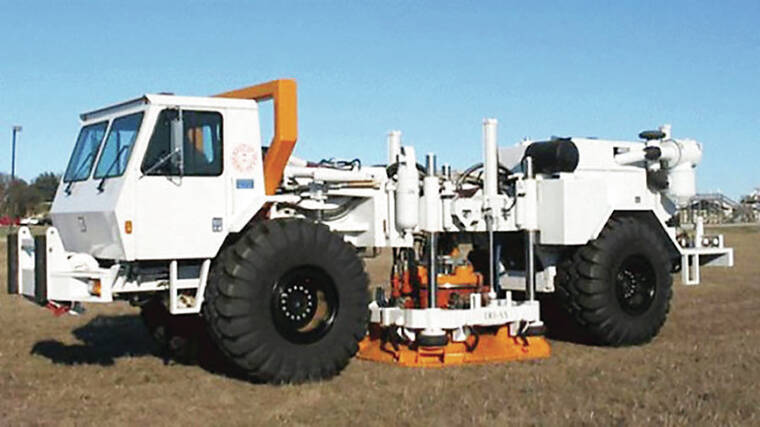Where is magma stored beneath the surface of Kilauea and how is it transported to the places where eruptions occur? Scientists have hypothesized the shape and size of Kilauea’s summit magma storage system for the last century, and now have an unparalleled opportunity to develop a far more detailed picture than was possible before.
A collaborative research project — the Kilauea Seismic Imaging Project — is about to start and it will help reveal subsurface structures beneath Kilauea’s summit region. This project is funded by the National Science Foundation and the USGS Additional Supplemental Appropriations for Disaster Relief Act of 2019 (H.R. 2157, provided in response to Kilauea’s 2018 lower East Rift Zone eruption and summit collapse).
The project will operate almost like a human CT scan. During a CT scan, your body enters a tube so that X-rays can travel through your body at different angles. From the X-rays, cross-sectional images are created of the features within your body, which are used collectively to make a three-dimensional model of your body.
During the Kilauea summit imaging project, seismic waves moving through the ground will be used to generate images of the subsurface that together will create a three-dimensional model of Kilauea’s summit magma storage geometry.
HVO has a permanent monitoring network of several seismometers at the summit of Kilauea that detect natural earthquakes, but more seismometers are needed to collect data at a higher resolution for this project. An additional 1,800 small earthquake-detecting devices, called seismic nodes, will be temporarily placed on the surface of Kilauea’s summit region in the next two months.
After the seismic nodes, which will blend into the natural landscape, are deployed, a large vehicle will slowly traverse roads near Kilauea’s summit in May. The vehicle, called a Vibroseis, will create tiny seismic signals. The Vibroseis is operated by engineers and field crews from the Natural Hazards Engineering Research Infrastructure experimental facility at the University of Texas at Austin, which is supported by NSF.
The nodes will capture the signals generated by the Vibroseis. The time that it takes the signals to reach the nodes and the way they change before reaching the nodes are important because seismic waves behave differently if the material they are traveling through is solid rock, semi-solid mushy material, or molten magma.
The vast amounts of data collected will be analyzed to outline where the base of Kilauea contacts the underlying ocean floor, the location of major faults and fault blocks, where bodies of magma are stored beneath the surface of Kilauea, and how those bodies connect to the rift zones.
The data will also produce a new velocity model for Kilauea’s summit region. Velocity models describe how fast earthquake waves move through subsurface regions and the model will allow for more accurate analyses of earthquakes and their locations in the future.
During April-June this year, you might see USGS scientists deploying or retrieving these seismic nodes across the summit of Kilauea volcano. Most of the work will be done from the ground, though there will be several days of helicopter-supported work.
We appreciate your patience if you experience any delays due to the Vibroseis vehicle slowly moving on roads in the region, including roads within Hawai‘i Volcanoes National Park, portions of Highway 11 near Kilauea summit, and segments of Wright Road and Haunani Road in Volcano Village. Unless you are close to the Vibroseis, you will not be able to feel the tiny vibrations or hear the whining noise the vehicle makes as it operates.
Results from this research project will be invaluable for assessing the ever-evolving hazards and future volcanic activity at Kilauea. The work is being conducted under a research permit from Hawai‘i Volcanoes National Park and with permission from the State of Hawaii Department of Transportation, Highways Division, and Department of Public Works, County of Hawaii. If you have any questions about the project, please email askHVO@usgs.gov. More details and updates on the progress of the Kilauea subsurface imaging project can be found here: https://www.usgs.gov/supplemental-appropriations-for-disaster-recovery-activities/science/2019-Kilauea-disaster-2.
Volcano activity updates
Kilauea is not erupting. Its USGS Volcano Alert level is ADVISORY.
Webcams show no signs of active lava in Halema‘uma‘u crater, at the summit of Kilauea in Hawai‘i Volcanoes National Park. Over the past week, summit tiltmeters showed inflation and seismicity was variable. The summit sulfur dioxide (SO2) emission rate was most recently measured on April 5, when it totaled 110 tonnes per day.
Mauna Loa is not erupting. Its USGS Volcano Alert Level is at NORMAL.
Webcams show no signs of activity on Mauna Loa. Seismicity remains low. Summit ground deformation rates show inflation above background levels, but this is not uncommon following eruptions. SO2 emission rates are at background levels.
There were three earthquakes with 3 or more felt reports in the Hawaiian Islands during the past week: a M3.4 earthquake 12 km (7 mi) W of Pauka‘a at 26 km (16 mi) depth on April 11 at 12:10 p.m. HST, a M2.8 earthquake 3 km (2 mi) WSW of Honaunau-Napoopoo at 4 km (3 mi) depth on April 8 at 11:31 p.m. HST, and a M2.8 earthquake 3 km (1 mi) SSW of Pahala at 31 km (19 mi) depth on April 7 at 3:55 a.m. HST.
HVO continues to closely monitor Kilauea and Mauna Loa.
Please visit HVO’s website for past Volcano Watch articles, Kilauea and Mauna Loa updates, volcano photos, maps, recent earthquake information, and more. Email questions to askHVO@usgs.gov.
Volcano Watch is a weekly article and activity update written by U.S. Geological Survey Hawaiian Volcano Observatory scientists and affiliates.

